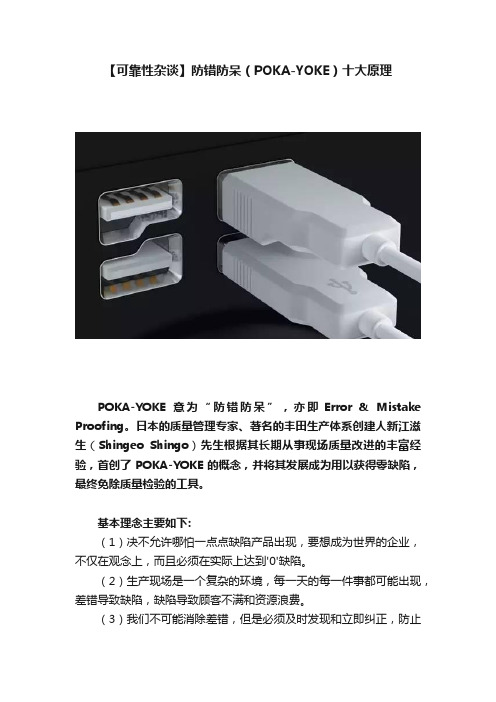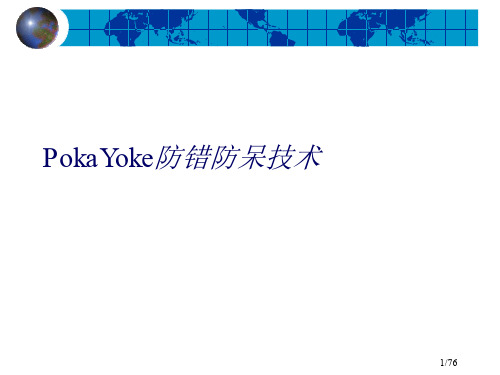Poka Yoke 减少失误 防差错技术
防错,防呆,防误(POKA-YOKE)培训

如果責任不分明時,應在總經理助理的主持下由各關聯問門開會討論決定. 假如責任須由兩個以上部門承擔時,則應給各責任問門分別發一人份問責表, 由他們各自完成對策,然后,統一匯總.
(4)問責表 (5)匯總結果
12
四.強化防錯意識
穩定無大錯 好的東西都是穩定的,一般不需要刻意改變.做到不盲目改動,保持現場穩定. 團隊防錯 要確保團隊能夠有效防錯,一個根本的方法就是樹立團隊成員的整體防錯 意 識,不要讓一部分人栽樹,另一部分人毀樹,而是要做到人人都栽樹,實施團隊防錯, 全面防錯. 防錯意識 企業要提高人員的防錯意識需要從基本管理抓起,建立制度,實施培訓,強化執 行,在此基礎上營造氛圍,塑造企業文化,讓員工自主開展工作,然后,一步步循序漸 進地深入,逐漸地潛移默化般形成.
業等,防錯就是識別潛在錯誤或超出產品和過程的設計,進而防止產生不良結 果;防誤則是設計可清楚地識別可能發生的錯誤并防止其形成不良后果的方 法. 2.實施POKA-YOKE的方法 POKA-YOKE的方法通常來自員工對工作的思考.具體內容主要是針對生 產中那些不容易控制的環節和人的意外行為,發揮創意,溶人智慧,穩定出可以 防止或解決的方法. 有效實施POKA-YOKE一般要從生產關聯的4M1E(人、機、物、料、環)五 大因素去展開,日本企業界的做法值得錯鑒,具體內容如下: 人員方面:進行多層次“三防”培訓教育,從一入社開始就先在思想上進 行灌輸,強化認識,塑造觀念,為以后充分發揮防錯奠定基礎;
◆用講故事的方式進行批評:
16
(3)實施三防必須從基礎抓起
實用的自動化方法通常包括如下內容:
9
機器、設備智能化:模仿人類的智力和思維方式,設置程序,使機器設備能 像人一樣去操作,自動化地完成各種運作;
防误防错poka yoke

防误防错poka yoke百科名片:POKA-YOKE意为“防误防错”,亦即Error & Mistake Proofing。
日本的质量管理专家、著名的丰田生产体系创建人新江滋生(Shingeo Shingo)先生根据其长期从事现场质量改进的丰富经验,首创了POKA-YOKE的概念,并将其发展成为用以获得零缺陷,最终免除质量检验的工具基本理念POKA-YOKE的基本理念主要有如下:⑴不允许哪怕一点点缺陷产品出现,要想成为世界的企业,不仅在观念上,而且必须在实际上达到“0”缺陷。
⑵⑵生产现场是一个复杂的环境,每一天的每一件事都可能出现,poka yoke书籍差错导致缺陷,缺陷导致顾客不满和资源浪费。
⑶我们不可能消除差错,但是必须及时发现和立即纠正,防止差错形成缺陷。
编辑本段基本概念剖析防误- 针对产品及过程设计出一种潜在的失效或导致失效的机理- 错误不可能发生- 前瞻性的- 预防防错- 做出改变,帮助操作人员减少或消除错误检(缺陷)- 防止错误在下游工序继续- 反应性的- 探测防误比防错更高级,更有效,例如十字路口,要避免南北向行驶的车辆与东西向行驶的车辆相撞,有两种办法,一是设置红绿灯,二是建立交桥。
但是设置了红绿灯并不能完全避免南北向行驶的车辆与东西向行驶的车辆相撞,因为有很多的司机会违规驾驶,红绿灯只能起到告警作用,这是防错。
但是如果建造了立交桥,就能完全避免相撞,这就是防误。
POKA YOKE 防错POKA YOKE防错术语过程设计防错产品设计防错零缺陷和POKA YOKE防错FMEA 和防错POKA YOKE实施POKA YOKE防错流程错误的种类人的错误的起因POKA YOKE防错级别和种类过程设计防错案例产品设计防错案例检验中的防错案例POKA YOKE防错技术的分类POKA YOKE防错探测技术的分类编辑本段基本原则消除(Elimination):将可能错误消除在过程和产品被重新设计的过程中;替代(Replacement):是进入更可靠的过程的一个变更;简单化(Facilitation):将过程运行变的更简单化,也更可靠;检测(Detection):使错误在下一步操作前被发现;缓和(Mitigation):是将错误的影响降低到最低。
Poka-Yoke防错技术(完整版)

在制造业中,由于操作人员的疲劳、技能水平不足、注意力不集中等原因,常常会出现制造缺陷和人为错误。这 些错误不仅会导致产品质量问题,还可能引发安全事故。因此,需要采用有效的防错技术来减少这些错误的发生。
防错技术的重要性
提高产品质量
通过消除人为错误,防错技术 可以显著提高产品的质量和可 靠性,从而增强企业的市场竞
概念
它强调在产品设计、制造和检验阶段, 采用各种技术和工具,以防止或检测 操作员或机器在生产过程中出现的错 误。
工作原理
防止错误发生
通过巧妙的设计,使得即使操作员犯 错也无法组装错误的产品零件或执行 错误的操作。
检测错误
通过特定的传感器、光电和限位开关 等设备,实时检测生产过程中的异常 情况,并及时发出警报或停止生产线 。
通过预防和纠正错误,poka-yoke防错技术有助于提高最终产 品的品质和一致性。
减少错误和浪费意味着降低了生产成本,提高了企业的经济效 益。
局限性
适用范围有限
poka-yoke防错技术主要适用于重复性高、 流程固定的生产过程,对于复杂或定制化的 生产可能不太适用。
依赖员工执行
poka-yoke防错技术需要员工严格遵守预设规则和 流程,否则难以发挥其应有的效果。
定制化
针对不同行业和企业的需求,poka-yoke防错技术将提供更加定制 化的解决方案,满足企业的个性化需求。
应用领域拓展
制造业
poka-yoke防错技术将继续在制造业中发挥重要作用,帮 助企业提高生产效率和产品质量。
01
服务业
随着服务业的不断发展,poka-yoke防 错技术将逐渐应用于服务业中,提高服 务质量和客户满意度。
制定改进目标
根据调查结果,制定具体的改进目标,如降低错误率、提高生产 效率等。
防错法(Poka-Yoke)

失误
漏放防震胶脚
漏检
漏打螺丝
漏贴铭牌
16
2020/9/1
缺陷 压缩机振动噪声大 外观凹花伤等 顶盖松动、卡条松脱 冰箱少铭牌,客户投诉
因为失误是造成缺陷的 原因,故可通过消除或 控制失误来消除缺陷。
防错法(Poka-Yoke)
产生失误的一般原因: 产生失误的基本原因有以下九个: 1、忘记:
更多EHS即独忘家记精了品作资业料或,检请查咨步询骤“,安比应如管忘家记”在微打信中号门:铰a螺ns丝yi之ngsj1 前先装上垫片。
防错法的定义: 防错法(Poka-Yoke),又称愚巧法、防呆法,意思是在
过程失误发生之前即加以防止。是一种在作业过程中采用自 更多动E作HS用独、家报精警品、资标料识,、请分咨类询等“手安段应,管使家作”业微人信员号不:特a别ns注yi意ngsj1
也不会失误的方法,换句话说,就连傻子都不会做错。
12
27
2020/9/1
防错法(Poka-Yoke)
产生失误的其他原因:
更多EHS独家精品资料,请咨询“安应管家”微信号:ansyingsj1
28
2020/9/1
防错法(Poka-Yoke)
制造过程常见失误:
制造过程不同,其失误种类也千差万别,但大致可归为以下 几类: 更多EHS独家01精、品漏掉资某料个,作业请步咨骤询“0安6、应工管件加家工”错微误 信号:ansyingsj1
13
2020/9/1
防错法(Poka-Yoke)
防错法的作用:
在作业过程中,作业者不时会因疏漏或遗忘而发生作业失误,由此 所致的质量缺陷所占的比例很大,如果能够用防错法防止此类失误的发
更多生E,H则S质独量家水精平品和资作业料效,率请必咨会询大幅“提安高应。管家”微信号:ansyingsj1
防呆法(防错法)Poka Yoke

将笔贴上姓名条或加条绳子固定在桌上;
11
2.1 分析思路
1、设计:材料、结构、工装夹具、工艺流程;
2、现场管理(制造):领料、操作方法、操作流程、自检、互检; 3、检测:检测方法、检测程序、检测频率; 4、自动预警:一旦问题产生可自动预警; Tips:
尽量采用不需思考而且简易方式(如自动化、标准化)避免可能产生的问题; 如果很难避免则采取措施尽量降低发生的频率、提高检测手段使其易被发现; 如果既不可避免又存在一定发生频率,只能通过确认、检测方式来实现;
注:往往传递的一些信息是附带隐性要求的,所以要确认与要求的符 合型;
10
1.3 应用原理
8、层别原理:为避免将不同工作做错,而设法加以区别出来; 例:颜色管理-以不同颜色来代表不同意义或工作内容; 9、警告原理:如有不正常的现象发生,能以声光或其它方式显示出 各种“警告”的讯号; 例: 安全带没系好或门没关好,车子会发出警告; 出货扫描时,信息输入错误发出自动警告; 10、缓和原理:无法排除问题发生,但可采取措施降低损害程度; 例:鸡蛋隔层装运盒减少搬运途中的损伤; 汽车之安全带,骑机车戴安全帽;
2
1.1 背景介绍
日本质量专家、丰田生产体系推动人之一新江滋生根据长期现 场质量改进的丰富实践,首创了poka yoke理念,并发展成获 得零缺陷、免检验的有效工具。 Poka Yoke的基本理念: 1、我们不可能完全消除差错,但是可以降低差错发生的概率或 产生的影响。而且必须及时发现和纠正,甚至能够自动预警甚 至是自动纠正差错; 2、在评估成本和风险的前提下,采取防止缺陷的产生,以零缺 陷为目标的措施;
防呆法(防错法) Poka Yoke Fool Proofing
1
开篇语
防错防呆(PokaPoka-yoke)十大原理及其应用案例

防错防呆(PokaPoka-yoke)十大原理及其应用案例防呆防错的方法多种多样,智慧的人们总结出主要有如下10大原理:1、自动原理:光、电、力、化学等来进行自动化控制;& 保险丝超过电流,自动断电;& 麦当劳烘干机开启烘干按钮后,10秒钟自动停止;& 商场节能电梯在感应到重力后才会开始工作;& 自动点胶机在启动按钮后,每次自动注射等量的胶量;2、断根原理:从根本上排除可能发生的源头;& 为了祛除狐臭,医生往往采用切断大汗腺的方法;& 为了祛除蚊子,可以进行场地清洁,以除去滋生蚊子的温床;& 为了控制全世界人民,美国孟山都公司逐步控制了世界粮食专利(控制核心);3、保险原理:必须有2个以上的动作同时开动才能继续执行下一步骤;& 操作人员必须双手同时启动2个冲床按钮才能操作,避免工伤事故;& 银行保险箱必须客户与银行工作人员同时打开才能取出物品;4、相符原理:确保两者形状、系统等特性匹配,来避免错误的发生;& 必须用对应的钥匙才能开门;& 登陆QQ或微博必须输入对应的账户和密码;& 规定渔网尺寸来避免鱼苗被打捞;& 医生手术会清点工具(确保工具槽是满的)来避免遗留患者体内;& 产品设计上采用形状匹配来避免操作人员匹配错误;5、隔离原理:远离危险现场,避免可能的错误;& 将危险品锁进柜子或放置高处,避免小孩误食;& 将不良品、嫌疑品进行隔离标识,以避免与良品混淆;& SMT刷锡膏及贴片必须在保护罩关闭以后才能工作;& 所有未校准或待维修的工具必须移除现场,进行隔离;6、顺序原理:避免顺序搞错而进行编号,可减少错误的发生;& 程序文件夹为避免取出后放错而进行斜线编号;& 儿童组装玩具通过编号组装可达到需要的形状;7、复制(确认)原理:也就是确认,可能是对我这辈子影响最大的就是“确认”;& 军队在上级向下级传达指令的时候,下级必须要复述,确保信息的正确传达;& 在信息传递时(如告知电话号码),需进行复述确认;& 在签订合同时,尽量采用一式几份,避免重复手抄出现错误;& 资料传递能够拷贝的尽量拷贝,避免人为手写错误;& 作业指导书可以指导操作员制造出相同品质的产品,并确保工作节拍的一致性;注意:在信息传递时,往往附带着一些隐性要求,需要进一步确认与要求的符合性;8、层别原理:避免将不同的工作做错,而设法加以区分;& 颜色管理,通过不同的颜色来识别对象状态;& 区域划分管理,避免不同区域间的混淆;& 工具按类别或配套管理,以匹配点检或使用;9、警告原理:如有异常发生,会自动以声、光、电提醒报警;& 电梯在超重情况下,会自动报警并停止工作;& 在安全带未系好时,汽车会自动重复报警;& 在出货扫描时,若发现与出货单不符,会自动警报提示;& 产线自动检测发现不良时,发出警报;10、缓和原理:无法排除问题的发生,但可采取措施降低损害程度;& 为了避免笔经常丢失,将笔用绳子绑在桌角;& 用保护膜保护产品,以避免产品被碰伤;所以,防呆防错法是一项非常贴切生活、工作的有效工具,在我看来是一项为人类作出巨大贡献的伟大发明。
Poka-Yoke 防错法

Running a red light 撞红灯
Forgetting to unplug your iron. 忘记拔掉电熨斗的插头
Placing the “original” in your copier feeder “face down”. 将原件放进了复印机的进纸处并正面冲下
or
9
Most Common Mistakes 最常见的错误
16
Example of Mistake-Proofing the Design 防错措施范例-设计
Process Description: Making a pot of coffee
程序描述:泡一壶咖啡
After Improvement: 改进后: Coffee maker was redesigned to measure and add the precise amount of water from a water bottle 重新设计咖啡机以使每次从水瓶中加入的 水的量都一样多
12
1-10-100 Rule
1-10-100 规则说明了一个产品或服务在它的生产流程中前进时 改正一个错误的成本将会十倍增加 活动 正确操作程序 在生产时检测到错误 客户检测到错误 不满意的客户还会和其他的客户分享经验的成本 成本 $1 $ 10 $ 100
$1000
13
Why do we do Mistake Proofing? 为什么我们要采用防错措施?
通知检验 –
降低缺陷(对从过程中得出的事实和数据,加以控制)
三种类: 统计质量控制体系 连续检验体系 自检体系
源头检验 –
去除缺陷(产品产出以前)
PokaYoke防错技术第部分

PokaYoke防错技术第一部分1. 概述PokaYoke是一种防错技术,其源自日文“poka”(ポカ)和“yokeru”(余計な手間)两个词,意为“避免不必要的失误和麻烦”。
PokaYoke最早应用于生产制造领域,旨在帮助工人在操作过程中不犯错误、不制造废品,提升生产效率,改善产品质量。
如今,这种方法已经被广泛地应用于各个领域,不仅为企业降低了成本、改善了效率和品质,同时也提高了消费者的安全保障和满意度。
2. 原理在制定PokaYoke的方法之前,了解操作人员、流程中可能存在的错误或误操作是首要的步骤。
PokaYoke的目标是通过降低把错误引入产品中的机会,从而降低重新制造产品或改正问题的成本。
因此,根据已有的数据源和其他信息,制定可行的、简单且易于遵循的PokaYoke解决方案是必要的。
PokaYoke的实现通常包括以下几个方面:•设计合理的流程:通过流程设计,明确每个步骤的具体内容和相互关系,避免操作人员在执行不同步骤时出现混淆或误解。
•确定关键环节:在流程中确定容易出错或造成重大问题的关键环节,例如常见的有料或无料、设备的位置等,并进行适当的标记或调整。
•引入检测机制:引入特定的检测机制来确保操作人员能够及时发现并更正错误或产品制造过程中的问题。
这具体包括设备故障警告、必要虚线和特定颜色的警告标识等。
•引入限制机制:在制造的过程中加入特定设计,使其只能进行一种操作,这能够减少错误的发生,例如机械键盘的按键机制。
3. 优点•降低成本:PokaYoke技术能够避免制造废品和重制成本,并且可以减少人力成本。
•提高质量:通过PokaYoke技术可以减少制造的缺陷,提高产品的品质水平。
•提高效率:PokaYoke技术可以减少出现错误的次数,提高生产效率,同时也可以提高工人的满意度和安全性。
•系统化:PokaYoke技术可以制定可行的、重复性的步骤,且可以联动整个生产过程,系统性很高。
•容易实施:PokaYoke技术不需要大量的技术知识和设备,只需要合理的流程设计,就可以很容易的实施。
PokaYoke防错法

提升工作效率:由 于 P o k a Yo k e 防 错 法能够在错误发生 前进行预警和纠正, 避免了因错误导致 的返工和重做,从 而提高了工作效率。
降低培训成本: 使 用Pok aYoke 防错法可以降低 对员工技能和经 验的依赖,减少 了培训成本和时 间。
提高安全性: P o k a Yo k e 防 错 法 能够在错误发生前 及时发现并纠正, 避免了因错误导致 的安全事故和风险, 提高了生产过程的 安全性。
险。
PART SIX
培训:提供针对PokaYoke 防错法的培训课程 ,包括理论知识和实践操作 ,确保员工掌握正确 的使用方法。
宣 传 推 广 : 通 过 各种 渠 道 宣 传 Po k a Yoke 防 错 法的 理 念 和优 势 , 提 高 员 工 对它 的 认 知 度 和 接 受 度。
内部培训师:培养内部培训师,定期开展PokaYoke 防错法的培训和交流活动 ,促进员工之间 的经验分享和学习。
教育:将PokaYoke 防错法纳入企业安全教育体系 ,对新员工进行培训 ,确保他们从入职开始 就能接受正确的安全意识和操作方法。
确 定 目 标 : 明 确Pok a Yoke 防错 法的 实施 目标 ,例 如减 少生 产过 程中 的错 误率 等 。
添加标题
添加标题
添加标题
添加标题
Байду номын сангаас
旅 游 业 : 利 用 P o k a Yo k e 防 错 法 , 避免旅游行程中出现错误,提升游 客体验。
酒 店 业 : 借 助 P o k a Yo k e 防 错 法 , 优化服务流程,提高客户入住体验。
制造业:通过 Po k a Yo k e 防 错法,减少生 产线上的人为 错误,提高产
Poka-Yoke防错法

未来发展与改进方向
降低成本
通过技术创新和优化设计,降低pokayoke防错法的成本,使其更具有市场 竞争力。
拓展应用领域
积极探索poka-yoke防错法在其他领 域的应用,如物流、医疗等,拓展其
应用范围。
提高技术水平
加强技术研发和人才培养,提高 poka-yoke防错法的技术水平和实施 效果。
加强国际合作与交流
验证与评估
验证效果
通过一段时间的观察和数据收集,验证防错装置 或方法是否有效地减少了错误的发生。
评估效益
对防错装置或方法的效益进行评估,包括经济效 益、操作简便性、可靠性等方面。
持续改进
根据验证和评估结果,对防错装置或方法进行持 续改进和优化,以提高其效果和可靠性。
poka-yoke防错法的应用案 例
Poka-yoke防错法的目的是通过消除错误源,减少生产过程中的不良品和浪费,提高生产效率和产品 质量。
意义在于降低生产成本、增强企业竞争力、提升员工技能和意识、促进企业可持续发展等方面。
02
poka-yoke防错法的种类
硬件防错法
总结词
通过使用特定的硬件设施来防止错误发生。
详细描述
硬件防错法主要通过设计专门的装置或工具来限制操作步骤或工件的位置,以 防止错误的发生。例如,在装配线上设置零件的固定位置,以确保工人将零件 正确地放置在正确的位置。
目视化防错法
总结词
利用可视化管理工具来提醒和防止错误。
详细描述
目视化防错法通过使用颜色、标签、标识等视觉元素来提醒操作者注意错误的可能性。 例如,在生产线上设置明显的警告标签或使用不同颜色的容器来区分正确的和错误的零
件。
03
poka-yoke防错法的实施步 骤
【可靠性杂谈】防错防呆(POKA-YOKE)十大原理

【可靠性杂谈】防错防呆(POKA-YOKE)十大原理POKA-YOKE意为“防错防呆”,亦即 Error & Mistake Proofing。
日本的质量管理专家、著名的丰田生产体系创建人新江滋生(Shingeo Shingo)先生根据其长期从事现场质量改进的丰富经验,首创了POKA-YOKE的概念,并将其发展成为用以获得零缺陷,最终免除质量检验的工具。
基本理念主要如下:(1)决不允许哪怕一点点缺陷产品出现,要想成为世界的企业,不仅在观念上,而且必须在实际上达到'0'缺陷。
(2)生产现场是一个复杂的环境,每一天的每一件事都可能出现,差错导致缺陷,缺陷导致顾客不满和资源浪费。
(3)我们不可能消除差错,但是必须及时发现和立即纠正,防止差错形成缺陷。
以下所举应用原理,以生活上所常见到的实例列举出来,希望能触类旁通应用于自己的工作上。
1、断根原理将会造成错误的原因从根本上排除掉,使绝不发生错误。
(1)借“排除”的方法来达成例:录音带上若录有重要的资料想永久保存时,则可将侧边防再录孔之一小块塑料片剥下,便能防止再录音。
2、保险原理借用二个以上的动作必需共同或依序执行才能完成工作(1)借“共同”动作必须同时执行来完成例:开银行保险箱时,须以顾客之钥匙与银行之钥匙,同时插入钥匙孔,才能将保险箱打开。
例:操作冲床之工作,为预防操作人员不小心被手夹伤,所以设计一双手必须同时按操作钮下去,才能执行工作。
3、自动原理以各种光学、电学、力学、机构学、化学等原理来限制某些动作的执行或不执行,以避免错误之发生。
目前这些自动开关非常普遍,也是非常简易的“自动化”之应用。
(1)以“浮力”的方式来控制例:抽水马桶之水箱内设有浮球,水升至某一高度时,浮球推动拉杆,切断水源。
(2)以“重量”控制的方式来完成例:电梯超载时,门关不上,电梯不能上下,警告钟也鸣起。
(3)以“光线”控制的方式来完成例:自动照相机,光线若不足时,则快门按不下去。
Poka-yoke

三、产生失误的原因
7、行动迟缓
NAMS
由于作业人员判断或决策能力过慢而导 致的失误,如系草焊接时间为3秒之內, 而作业員5秒后才将漆包线从錫槽內拿出, 而导致绝缘不良。
8、缺乏适当的作业指导
由于缺乏作业指导或作业指导不当,发 生失误的概率是相当大的。
一、防错法的作用
1、防错法意味著“第一次把事情做”。
NAMS
因为防错法采用一系列方法和或工具防止失误 的发生,某结果即为第一次即將事情做好。
2、提升产品品质,减少由于检查而导致的浪費
防错法意味著“第一次即把事情做好”,直接 结果就是产品品质的提高,与靠检查來保证品质 相比,防错法是从預防角度出发所采取的預防措 施。而检查不能防止缺陷的产生,检查发现的缺 陷只能去纠正。这是一种浪費,防错法消除了这 种浪费。
四、传统做法
主观差错
疏忽、遗忘 理解错误 判断失误 外行、缺乏专业技能 固执已见,凭经验办事 注意力不集中 反应迟缓 缺乏标准 措手不及 故意
NAMS
传统作法
强调责任心
批评+指责 纪律 +惩罚
实际效果
教育
无 明 显 改 善
四、必须换个思路
信 念: 积极预防缺陷才是减少不合格的正确途径
NAMS
探 索:
二、产生失误的原因
典型的缺陷:
NAMS 缺陷的起因:
1. 未动作 2. 误动作 3. 工件装夹位置错 4. 漏零件 5. 送错零件 6. 工具与模具用错 7. 调整错
三、产生失误的原因
1、忘记
即忘记了作业或检查步骤,比如忘記在 打螺丝之前先装上垫片。
NAMS
Poka-Yoke防错技术(完整版)

错误是如何发生的?
现代质量管理之父 后现代工业革命(第三波工业革命)之父
还有什么导致了错误的出现
还有什么导致了错误的出现
还有什么导致了错误的出现
还有什么导致了错误的出现
还有什么导致了错误的出现
还有什么导致了错误的出现
还有什么导致了错误的出现
还有什么导致了错误的出现
还有什么导致了错误的出现
还有什么导致了错误的出现
还有什么导致了错误的出现
还有什么导致了错误的出现
还有什么导致了错误的出现
还有什么导致了错误的出现
误导产生的错觉 过分关注产生的幻觉 观察的细致程度 观察的不同角度 悖论 惯性思维 盲点
错误—缺陷的后果
增加成本 时间损失 带来危险或可能的伤害 丢失业务
意 意图 图
过程的某一 部分希望如 何运转
偏 偏离 离
与意图 相背离
原 原因 因
发生偏离的原因。一旦显 示出一种偏离,一定有其 可信的或实际的原因
后 后果 果
所发生偏 离的结果
缺 缺陷 陷
来自于HAZOP的偏离分析
指导语句:是对意图进行定性的简明用语,以便引导和激发创造性 的思维过程,从而发现偏离。
消除错误—缺陷的意义
Zero Defects——零缺陷目标
– 减少各种错误-缺陷-损失 – 减少浪费(Muda) ——增加正向收获 – 降低废品率,减少返工 – 向消除质量检验迈进,降低检验成本
提高工作质量、强化效率 将操作人员的时间和精力解放出来,以从事更具有创造性和附加
价值的活动,从而使员工通过更多的参与获得成就感与满足感 增强安全性并适应环境保护的需要 降低质量风险、优化产品性能、提高顾客满意度,获取最大竞争
PokaYoke防错防呆技术

目標
削除 消除可能的失誤
替代
用更可靠的過程代替目 前的過程以降低失誤
簡化 使作業更容易完成
檢測
在缺陷流入下工序前對 其進行檢測並剔除
減少 將失誤影響降至最低
方法
評價
通過產品及制造過程的重 新設計, 加入poka-yoke方 最好 法
運用機器人技術或自動化 生產技術
較好
合併生產步驟, 實施工業 工程改善
7/76
二、失誤與缺陷
失誤 漏加錫 漏檢 漏裝螺絲 漏關煤氣
缺陷 元件半焊 外觀凹痕 産品少螺帽 燒裂水壺
因為失誤是造成缺陷的原因,故可通過消或控制失誤來消除缺陷。
8/76
三、産生失誤的一般原因
産生失誤的基本原因有以下九個:
1、忘記
即忘記了作業或檢查步驟,比 如忘記在打螺絲之前先裝上墊片。
9/76
PokaYoke防错防呆技术
1/76
第一節 防錯法概述
防錯法日文稱PKKA-YOKE,又稱愚 巧法、防呆法。意即在過程失誤發生之 前即加以防止。是一種在作業過程中采 用自動作用、報警、標識、分類等手段, 使作業人員不特別注意也不會失誤的方 法。
2/76
一、防錯法的作用
在作業過程中,作業者不時會因疏漏 或遺忘而發生作業失誤,由此所致的 品質缺陷所占的比例很大,如果能夠 用防錯法防止此類失誤的發生,則品 質水平和作業效率必會大幅提高。
38/76
2、替代法
替代法是對硬件設施進行更新和改善, 使過程不過多依賴於作業人員, 從而降低 由於人為原因造成的失誤(占失誤的部分)。 這种防錯方法可以大大防低失誤率, 為一 种較好的防錯方法, 缺點在於投入過大, 另外由於設備問題導致的失誤無法防止。
Poka-Yoke防错技术(完整版)

还有什么导致了错误的出现
还有什么导致了错误的出现
还有什么导致了错误的出现
还有什么导致了错误的出现
还有什么导致了错误的出现
误导产生的错觉 过分关注产生的幻觉 观察的细致程度 观察的不同角度 悖论 惯性思维 盲点
错误—缺陷的后果
增加成本 时间损失 带来危险或可能的伤害 丢失业务
损失最小!
传统解决缺陷的方法是:
及时地发现缺陷,并尽可能地找出发生缺陷的原因,采取纠正措施,防 止以后此类缺陷的再次发生,使以后出现的缺陷便会越来越少,直至完 全排除缺陷。
注意:这种传统的方法是缺陷已经发生,也已经造成了损失。 同时:有些缺陷和失误造成的后果无法挽回…..
如果事情做对了99.9%会意味着是什么?
消除错误—缺陷的意义
Zero Defects——零缺陷目标
减少各种错误-缺陷-损失 减少浪费(Muda) ——增加正向收获 降低废品率,减少返工 向消除质量检验迈进,降低检验成本
提高工作质量、强化效率 将操作人员的时间和精力解放出来,以从事更具有创造性和附
加价值的活动,从而使员工通过更多的参与获得成就感与满足 感 增强安全性并适应环境保护的需要 降低质量风险、优化产品性能、提高顾客满意度,获取最大竞 争优势
机器亦然
同样的方法,同 样的时间和同样的 地点,不同的人
同样的方法,同 样的人和同样的地 点,不同的时间
同样的方法,不 同的人,不同的地 点,不同的时间
同样的方法,同 样的人,不同的地 点,不同的时间
错误和缺陷
错误是预期过程的任何偏离,是人们由于疏忽、无意识等偶 尔犯下的。
缺陷是错误的后果。 所有的缺陷由错误产生; 不是所有的错误都产生缺陷。
防错法Poka-Yoke

防错法Poka-Yoke简介防错法Poka-Yoke是一种用于预防和消除错误的技术,最初起源于丰田汽车公司,后逐步被广泛应用于制造业、服务业和医疗行业等领域。
它的意义在于:通过设计和改进生产过程,避免或降低质量问题的发生,从而提高产品和服务的质量水平。
原理Poka-Yoke的思想源于日本的精益生产理念Lean Production,它的核心理念是将生产过程中的误差和浪费降至最低,使生产过程变得高效和精准。
Poka-Yoke技术主要通过以下两种方法实现:1.设计防错:将产品或服务的设计与生产过程同时进行,从而建立一个具有自我验证功能的系统,能够防止人工操作时出现的错误。
例如,在日本某家汽车公司生产线上,零件盒子的颜色与对应的车型颜色相同,这样就可以避免工人错误地安装零件。
2.操作防错:通过在生产过程中加入特殊的检查机构或工具,来帮助工人在工作中正确地执行操作,从而避免人为因素导致的误差。
例如,在某家医院中,医生在给病人进行手术前,必须扫描手术包内的条码,以确保使用正确的工具和药品。
应用Poka-Yoke技术可以应用于各个领域,以下是几个典型的应用案例:1.制造业:在汽车生产线、家电生产线等制造领域,可以通过改进生产系统和工艺流程,设计出具有自我验证能力的产品,加强操作培训,从而防止发生生产缺陷。
2.服务业:在酒店、餐厅等服务领域,可以通过规定服务标准、强化员工培训,以及通过加入检查清单等方式,避免因服务流程混乱、服务环节疏漏,导致服务质量下降。
3.医疗行业:在医疗领域,医院可以引入手术检查清单、术前术后指导等Poka-Yoke技术,从而防止患者术后感染、误用药品等问题。
总结防错法Poka-Yoke是一种重要的生产管理理念和方法,通过改进生产过程、设计具有自我验证功能的产品系统,以及加强操作培训、确定服务标准等方式,可以有效地提高生产质量和服务质量。
Poka-Yoke 技术的应用价值在于避免在服务、生产和工作过程中出现的失误和相关问题,提高员工的效率、减少成本和时间浪费,从而可以使企业更加稳定和有效地运营。
Poka-Yoke防呆措施

常见的防差错装置
最常见的防差错装置有五种——定位销、出错 报警器、限位开关、计数器、检查表。
按照预防差错的方式不同,可分为:
• 限制式——定位销、限位开关、异形接口均属 此类,当差错即将发生时,用停止操作的方式 及时制止或用强制导向的方式加以纠正。 • 警告式—报警器,采用蜂鸣或灯光预报差错, 提请操作者采取措施。 • 助记式——计数器、检查表属于此类方式,当 你前往超市购物时,为避免遗忘,最简单的方 法就是先列一张购物表,逐项核对。
主观差错是指由于操作人员的失误所造成的差 错,大致归纳为以下几类: 疏忽 理解错误 判断失误 生疏、缺乏应有的专业技能 固执己见,凭经验办事 心不在焉,注意力不集中 反应迟缓 缺乏指导 明知故犯等
为了防止这些差错,在作业现场一般会制定 许多规章制度并采用纪律约束,而当差错发 生时,传统的做法是批评、职责、教育直到 处罚。事实上,很多工厂的经验表明,上述 措施只能防范一部分主观差错。
防错
防错
• 质量渗透在每一步工序之中——当差错已产生, 唯一办法是100%检验,以免形成缺陷产品。 • 所有的差错和缺陷都必须受限——根据迹象,预 设限制。 • 知错就改,切忌延误。 • 不要找理由开脱,要想办法做对。 • 只要有60%把握成功,就该立即动手。 • 只要人人参与,差错才能为0。 • 三个臭皮匠,赛过一个诸葛亮——团队工作方式 至关重要。 • 不要草率下结论,多问几遍“为什么?”
(4)预防控制优于事后纠正 在自动生产线上,高速运行的设备往往在极短时间内就加工出 大量零件,传统技术在探测、判别、反馈与纠正之间的时间延 误会造成大量缺陷产品。而POKA-YOKE装置的控制行动几乎 是与发现差错同步进行的,因此能够预先防止或及时制止差 错,从而杜绝缺陷。 防差错系统(POKA-YOKE)是寻因检验与预防控制技术的综 合应用,特别适用于限制人为差错。它可以替代大量的人工检 验。但是,在需要凭感官进行探测和判断的场合,目前应用还 不够普遍。相信随着现代科学技术的发展使得测量手段越来越 丰富,越来越先进,这方面的突破指日可待。
- 1、下载文档前请自行甄别文档内容的完整性,平台不提供额外的编辑、内容补充、找答案等附加服务。
- 2、"仅部分预览"的文档,不可在线预览部分如存在完整性等问题,可反馈申请退款(可完整预览的文档不适用该条件!)。
- 3、如文档侵犯您的权益,请联系客服反馈,我们会尽快为您处理(人工客服工作时间:9:00-18:30)。
Parker Lean System Poka-YokeObjective•Define Poka-Yoke•Describe the purpose of Poka-Yoke•Given a work scenario, describe examples of how Poka-Yoke could be employed.•Distinguish the difference between mistake proof and fail safe•Describe the ideal approach of Poka-Yoke.•Describe characteristics of Poka-Yoke solutions.•Given examples of Poka-Yoke solutions, identify what is good and what could be improved.Poka Yoke•POKA -inadvertent error•YOKE -proof•Pronounced (POH-kah YOH-kay)In the original Toyoda Loom, Jidoka was the principle of stopping work immediately when a defect occurred. Poka Yoke was the device that made it possible.Original Toyoda Loom -JidokaSources of Defects•Inappropriate process specifications •Excessive process variability •Material properties and variability •Machine performance and variability •Inadvertent errors–Humans or machinesErrors Vs. Defects•Product defects result from errors and mistakes •Errors and mistakes will always be potential issues with operations involving people •Machines can make mistakes tooWe can achieve Zero defects by catching these errors and mistakes and preventing themfrom becoming product defectsErrors Vs. DefectsMistakes (errors) are inevitable“A human is an animal that makesmistakes”--Shingo1001 in 110-11 in 1010-21 in 10010-310-410-510-6(Highest)(Lowest)Crew reaction duringair disasterSimulated militaryemergencyPassive inspections(general walk -arounds )Monitor/inspector fails to recognize initial error by operatorSimple arithmetic errors (without re -doing calculation on separate paper)Missetting largemanual values (nostatus indication except open orclosed)Technician “seeing ”an out of calibration instrument as “intolerance ”General error of omission (no control room display)General error of omission for itemsembedded inprocedureSelection of switch dissimilar in shapeor location todesired switchMissetting large manual valves (controlled by procedure keys, chaining, etc.)Selection of key operated switch rather than non -key switch (does not include error of decision)General errors of commission (e.g., misread label and selected wrongswitch)Upper limit to credibility Two -man team (one do; one check then reverse roles)SOURSE: System Safety 2000, Joe Stephenson (New York: Van Nostrand Reinhold, 1991)Human Error RatesPoka Yoke•Makes permanent changes to equipment,operations, or procedures to eliminateopportunity for error•Provides an immediate signal if a mistakeoccursMistake Proof & Fail Safe Mistake Proof / Fail Safe techniques are partof a Poka-Yoke system•Mistake Proof –Practices and devices thatmake it easy to do it right and difficult orimpossible to do a task wrong.•Fail Safe –If anything does go wrong, itimmediately becomes impossible tocontinue (Jidoka)Ideal Function of Poka-Yoke Linkage to Jidoka and a Zero defect system •Source inspection to detect errors at theirsource•100% inspection for errors/mistakes anddefects using inexpensive sensing devices •Immediate action to stop operations when an error is detectedContact Sensors•Used to physically detect the presence or absence of an object or feature.•Used to physically detect the height orposition of a part or dimension.Impact of Poka YokeState of Defect Source Informative InspectionRegulation Impact Predicted ShutdownAnnunciationLine StopFeedback &Adjust WarningAnnunciationZero Defects (Defect Prevention)Detected Scrap & Rework(Defect Reduction)SameMistake Proof3.5 inch diskette. The diskettecannot be inserted unless it isoriented correctly. This is as faras a disk can be inserted upside-down.The beveled corner of thediskette pushes a stop in the diskdrive out of the way allowing thediskette to be inserted. Thisfeature, along with the fact thatthe diskette is not square,prohibits incorrect orientation.Mistake Proof110 volt outlets in NorthAmerica. All “grounded”items have a thirdprong that only fits oneway in the receptacle.Even two prong /ungrounded items thatare polarity sensitivecan be forced to beplugged in the sameway due to differentsized prongs on boththe plug and outlet.Here is a parts kit for an assembly operation. Can you easilytell if we have all of the right parts? Signed Packing ListMistake ProofMistake ProofThis bathroom sink has asmall hole near the top thathelps prevent overflow.This is a parts kit for an assembly operation that uses a picture. Can youtell which parts have already been installed?Mistake ProofThis automatic coffee pot is equipped with a “pause and serve ”feature. When you remove the pot, the flow isinterrupted by this simple valve.Images from John Grout: /faculty/jgrout/pokayoke.shtml Fail SafeFail SafeA special coupling on gas pumps allows the line to break away and seal if somebody drives away.Mistake Proof & Fail SafeMistake Proof & Fail SafeSki Boots and Bindings.When a skier falls and a skicomes off, a “runaway ski”can cause serious injury. SkiBrakes prevent this fromhappening by automaticallyDowndropping down when the skiboot is no longer in thebinding. They also fold upautomatically when a skiersteps into their skis.RetractedCharacteristic of PokaYoke Solutions •Simple•Inexpensive•Integral part of the process•Placed at the source of errors–Point of transformation (Process Function)•Capable of 100% inspection•Provide quick feedback–(Effective human support system in place)•Ideas generally originate on the shop floor•Prevents process or part from moving forward if errors occur.Poka Yoke Aids•Colors and color-coding •Shapes / sizes •Symbols•Other toolsDegrees of Poka-YokeIs it hard or impossible to do something wrong?•Both meet the definition of Mistake Proof•Example: Color coding doesn’t make it impossible •Impossible to do wrong is always better•Layer techniques for maximum effectLayers of Mistake ProofTrailer plug. This isthe quick disconnectelectrical connectorused to hook up thelights on a trailer to atow vehicle. Thereare two layers of MPhere: color coding(white, green, yellow& brown wires) andthe physical shape ofthe connection.What’s good? How to Improve?This form uses mistake-proofing to help the user fill out the form correctly.ExerciseBreak into teams and develop Poka Yoke devices for:•Getting to this classroom•Making sure the lights are turned off•Making sure the computers are logged off•Making sure the room is locked•Making sure the students arrive on time•Other?Remember, layers are sometimes important!Homework。
